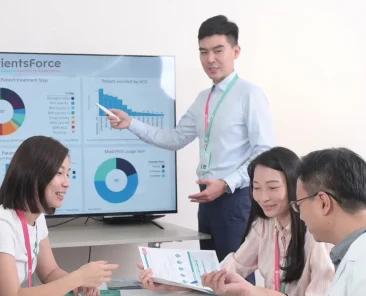The product lifecycle service of a drug is from the pre-market clinical trial of a new drug to the sales service after obtaining a drug license, but the core problem is to solve the issue of patient access to medicine treatment. With the trend of accelerating the launch of new drugs, a more strategic patient support service concept, Patient Solution has also evolved from PSP (Patient Support Program) to the market-leading EAP (Expanded Access Program).
At the heart of the Patient Support Program (PSP) is the sustainable journey of “making patients use it well.” This is a long-term service that spans before and after drug approval, aiming to help patients get the medication they need, improve medication adherence, manage side effects, and provide daily life and financial support. A well-designed PSP can significantly improve clinical outcomes and ensure that the efficacy of a drug is “seen” and “maintained” in the real world. These first-hand real-world data obtained through close interaction with patients and medical devices in PSP have become intangible assets for drug research and development.
As pharmaceutical companies prepare to launch the next generation of new drugs or new indications, these data and insights accumulated from PSP can play a key role. These insights can be used to assist in the design of new dosage forms or indications; EAP is a passive mechanism approved for emergency use before drug marketing to address urgent patient needs, but it is more targeted and strategic from the perspective of the drug product cycle.
A closed loop of services driven by “physician treatment plan” as the core
As a Patient Solution Provider, PatientsForce understands that EAP and PSP are not isolated service items, and their common starting point is the physician’s treatment plan to respond to patient needs.
- The Beginning of PSP: Once a doctor prescribes it, the PSP journey unfolds. PatientsForce’s services intervene from this point on, providing comprehensive support from medication education, payment navigation, financial assistance, and medication reminders to ensure that patients can follow their doctor’s treatment plan smoothly and consistently.
- Reverse Extension of EAP: When physicians assess that a patient’s condition is critical and existing treatment options are no longer effective, PatientsForce can use patient journey data accumulated from PSPs to assist physician teams in navigating complex EAP application processes, monitoring medication safety, and ensuring a stable drug supply, allowing physicians to focus on the most critical medical decisions.
This “patient-centric” service model drives physician treatment plans, seamlessly connecting EAP and PSP into a strategic closed loop of “value/evidence/accessibility”:
- Value: Continuously collect real-world treatment results through PSP to visualize the “drug value”.
- Evidence: This valuable data becomes data for communication with HTA (pharmacoeconomics and payers) while finding more precise solutions.
- Accessibility: EAP data also serves as evidence for further clinical outcomes, accelerating the approval of new drugs or indications, thereby improving accessibility.
Patient Solution Provider’s Value Empowerment: From “Compliance” to “Verifiable”
A successful PSP service professional is not only the executor of the process but also the enabler of strategy. PatientsForce internalizes the following five modules as the core of its services:
- Unmet Needs Segmentation: Accurately identify patients who need it most and provide tailored services based on their treatment journey.
- Evidence & Funding Pathway: Assist pharmaceutical companies in translating PSP data into a language that payers can understand and participate in the design of Managed Access Agreements.
- Compliance & Risk: Embedded with stringent Anti-Kickback, Pharmacovigilance (PV), and data protection (e.g., DPIA) processes to ensure services operate under the highest compliance standards.
- Service & Operations: Provide services such as “Quick Entry” and “Ongoing Support” through multi-channel integration, with contact rates, adherence, and treatment outcomes as key performance indicators (KPIs).
- Data & Insight: Establish a standardized data collection framework to digitize patient feedback (PROs) and treatment outcomes, providing verifiable insights for pharmaceutical companies’ business decisions.
PSP ensures the sustainability of “using it well, proving it, and affording it”, while EAP solves the urgency of “use it first” on this basis. From the perspective of business management, true competitiveness does not lie in the optimization of a single link, but in the integration of regulatory compliance, evidence collection, payment dialogue, and service design into a complete closed loop with patients at the core.
PatientsForce works with multinational pharmaceutical companies to assist physicians and patients with EAP to PSP patient support services under compliance system management.
Register:
The full English name of EAP is Early Access Program, which is the Early Access Program. It refers to the conditional and supervised use of drugs or therapies for patients with serious, life-threatening diseases and no other effective treatment options before they have been officially approved for marketing by the competent authorities. EAP is a special humanitarian mechanism that allows patients to obtain and use new drugs that are still under development early in addition to clinical trials to meet urgent medical needs.
Each country has different names and specifications for EAP, but the basic spirit is similar:
- US FDA: Expanded Access (or Compassionate Use)
- EU EMA: Compassionate Use Programme
- UK MHRA: Early Access to Medicines Scheme (EAMS)
- Health Canada: Special Access Programme (SAP)




